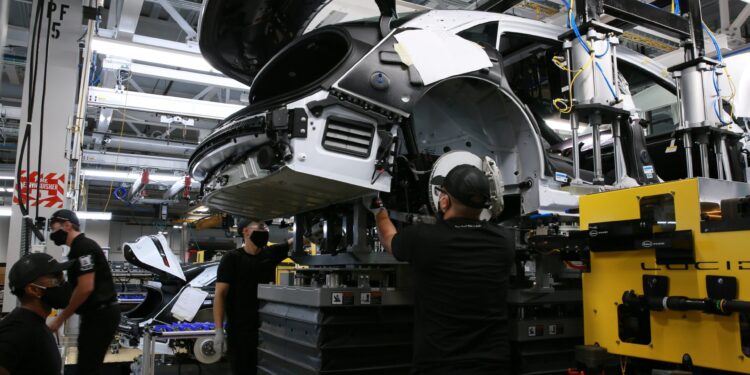Can America Compete? Assessing China's Electric Vehicle Industry Dominance

Table of Contents
China's Strengths in the Electric Vehicle Market
China's dominance in the EV market isn't accidental; it's the result of a strategic combination of factors.
Massive Domestic Market & Government Support
China possesses the world's largest EV market, creating unparalleled economies of scale. This massive demand fuels innovation and allows Chinese EV manufacturers to achieve cost efficiencies unavailable to smaller markets. Government support plays a crucial role, providing substantial subsidies, tax breaks, and significant investments in charging infrastructure nationwide. This proactive approach has fostered a thriving ecosystem for electric vehicle development and adoption.
- Government Initiatives: Substantial subsidies for EV purchases, tax incentives for manufacturers, massive investment in nationwide charging networks, and favorable regulations.
- Successful Chinese EV Models: BYD's diverse range of EVs, NIO's innovative battery-as-a-service model, and several other successful Chinese brands have captured significant market share globally.
- Market Share Data: China's consistent dominance in global EV production and sales demonstrates the power of its integrated strategy.
Dominance in Battery Technology and Supply Chains
China's control extends beyond vehicle assembly; it holds a significant advantage in battery technology and supply chains. China controls a substantial portion of the mining and processing of critical battery raw materials like lithium, cobalt, and nickel. This control directly impacts battery costs and global availability, giving Chinese manufacturers a significant cost advantage. Furthermore, Chinese companies are at the forefront of battery technology innovation, constantly pushing the boundaries of energy density and charging speeds.
- Key Battery Materials: Lithium, cobalt, nickel, and other crucial materials are predominantly sourced and processed in China.
- Manufacturing Processes: China has optimized its battery manufacturing processes, leading to higher efficiency and lower production costs.
- Technological Advancements: Chinese companies are pioneering advancements in solid-state batteries and other next-generation battery technologies.
Cost Advantages and Manufacturing Efficiency
Lower labor costs in China compared to the US significantly contribute to lower EV production costs. Coupled with efficient manufacturing processes and well-established supply chains, Chinese manufacturers can produce EVs at a considerably lower cost than their American counterparts. This cost advantage allows them to offer competitive pricing in both the domestic and global markets.
- Labor Cost Comparisons: A stark difference exists between manufacturing labor costs in China and the US, impacting the final price of EVs.
- Manufacturing Efficiency Metrics: Chinese factories often utilize highly automated and efficient production lines, increasing output and reducing costs.
- Cost Analysis: Comparing the bill of materials and manufacturing costs reveals a significant cost advantage for Chinese EV producers.
Challenges Facing the American Electric Vehicle Industry
While the American EV market shows promise, several challenges hinder its ability to compete effectively with China's dominance.
Higher Production Costs and Labor Regulations
Higher labor costs and stringent environmental regulations in the US significantly increase the cost of producing EVs. These factors, combined with the influence of unions and labor negotiations, make it difficult for American manufacturers to compete on price with Chinese producers.
- Labor Cost Comparisons: The considerable difference in labor costs between the US and China directly impacts the competitiveness of American EVs.
- Regulatory Hurdles: Stringent environmental and safety regulations add to production costs in the US.
- Effects on Production Timelines: Regulatory compliance can lead to longer production timelines, potentially hindering market competitiveness.
Supply Chain Vulnerabilities and Dependence on Foreign Materials
The US relies heavily on foreign sources for critical EV materials, creating supply chain vulnerabilities and increasing dependence on geopolitical stability. This reliance exposes the American EV industry to potential disruptions caused by international conflicts or trade disputes. Efforts to build a more resilient domestic supply chain are crucial to address this vulnerability.
- Key Materials: The US imports significant quantities of lithium, cobalt, and other essential EV materials.
- Sources of Import: China, Australia, and other countries are primary sources of these critical materials.
- Risks Associated with Dependence: Geopolitical instability or trade disputes can significantly impact the supply and price of these materials.
Consumer Preferences and Market Acceptance
Consumer preferences in the US market are a crucial factor influencing EV adoption. While EV adoption is growing, several factors, including price sensitivity, range anxiety, and the availability of charging infrastructure, still pose challenges. Understanding and addressing these consumer concerns is essential for the growth of the American EV market.
- Market Research Data: Surveys and data analysis reveal consumer preferences and concerns regarding EV purchase.
- Consumer Surveys: Consumer sentiment towards various EV brands and features can inform product development and marketing strategies.
- Brand Preference Statistics: Analyzing brand preference reveals the level of competition and market share held by different manufacturers.
Conclusion
China's dominance in the electric vehicle industry is undeniable, fueled by a massive domestic market, government support, control over battery supply chains, and cost advantages. The American electric vehicle market faces significant challenges, including higher production costs, supply chain vulnerabilities, and consumer preferences. However, the US possesses significant technological capabilities and can leverage innovation to compete. Strengthening the American electric vehicle market requires strategic investments in domestic battery production, development of robust supply chains, targeted government incentives, and a concerted effort to address consumer concerns. Only through a proactive and comprehensive approach can America hope to meaningfully challenge China's dominance in this crucial sector of the future. Investing in American innovation and creating a more competitive environment for electric vehicle manufacturing are critical for securing the nation's future in the global EV market.

Featured Posts
-
 Eight Hours In A Tree A Migrants Escape From Ice Detention
May 05, 2025
Eight Hours In A Tree A Migrants Escape From Ice Detention
May 05, 2025 -
 Tioga Downs Preparations Underway For 2025 Race Season
May 05, 2025
Tioga Downs Preparations Underway For 2025 Race Season
May 05, 2025 -
 Bakole Vs Parker Ajagbas Ibf Roadblock
May 05, 2025
Bakole Vs Parker Ajagbas Ibf Roadblock
May 05, 2025 -
 Nicolai Tangens Response To Trump Era Tariffs
May 05, 2025
Nicolai Tangens Response To Trump Era Tariffs
May 05, 2025 -
 Stream The Kentucky Derby 2025 A Complete Guide To Online Viewing Options
May 05, 2025
Stream The Kentucky Derby 2025 A Complete Guide To Online Viewing Options
May 05, 2025
